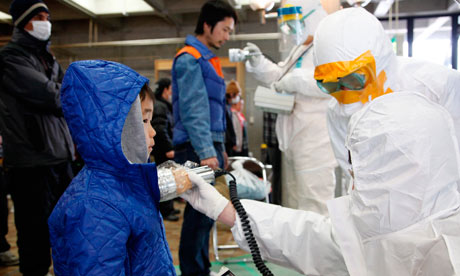IAEA urges Japan to give more information on nuclear crisis
by editor | 2011-03-18 7:33 am
![]()
The message came as trucks doused a reactor at the Fukushima Daiichi facility with dozens of tonnes of water in a renewed attempt to cool the reactor
Tania Branigan
A radiation testing centre in Koriyama City. The EU’s energy chief said the Fukushima plant was ‘effectively out of control’. Photograph: Tayama Tatsuyuki/Gamma-Rapho/Getty Images
The head of the United Nations’ nuclear watchdog has urged Japan[1] to provide more information on its “extremely serious” crisis as the battle to regain control of a failing power plant enters a second week.
Yukiya Amano, the International Atomic Energy Agency chief, told prime minister Naoto Kan that although it had been briefed, “there is the opinion in the international community that more detailed information is needed”.
Earlier, as he arrived in Tokyo, Amano told reporters: “This is not something that just Japan should deal with, and people of the entire world should cooperate with Japan and the people in the disaster areas.”
Fire trucks are dousing a reactor at the Fukushima Daiichi facility with dozens of tonnes of water in a renewed attempt to cool the reactor posing the biggest threat at present.
Officials have warned that the nuclear incident is hampering efforts to deliver aid to victims of last Friday’s earthquake and tsunami, with reports that drivers are reluctant to go to areas even outside the exclusion zone.
Shortages of petrol and obstructed routes have also left many in the 2,200 emergency shelters across the disaster zone short of food, fuel, water and medicine. Yoshihiro Murai, governor of the worst-hit prefecture, Miyagi, urged survivors to move away, saying it would be difficult to provide housing in the near future.
More than 6,400 people have been confirmed dead, police have said, including more than 3,600 in Miyagi. In Iwate more than 1,900 are confirmed dead, while the figure for Fukushima is approaching 600. The fate of tens of thousands more remains unknown.
Early signs offered some hope that radiation levels might be stable or even dropping at the Fukushima No 1 nuclear plant after police water cannons and helicopters doused unit 3 yesterday. NHK reported that measurements taken near the facility’s west gate fell from 309 microsieverts per hour to 271 microsieverts. There have been enormous variations in readings at different parts of the plant and within short spaces of times.
More than 20 fire engines – one of them able to discharge water at a rate of 5 tonnes per minute – are dousing unit 3. The water levels in the spent fuel pool are thought to be almost depleted. It is thought that exposed rods led to significant increases in radiation levels in the last two days.
There is also concern about unit 4 and water levels in number 1 are thought to be decreasing. The pools in units 5 and 6 are also thought to be warming, but are of less immediate concern.
A spokesman for the Japanese nuclear agency said steam or smoke was seen at unit 2 this morning – where an earlier explosion may have damaged the containment vessel – and acknowledged that the authorities could yet bury the reactors in sand and concrete, as happened at Chernobyl in 1986.
Hidehiko Nishiyama said the priority was adding water to the spent fuel pools. Asked about the “Chernobyl solution”, he replied: “That solution is in the back of our minds, but we are focused on cooling the reactors down.”
The units may not cool down for weeks, the head of the US nuclear regulatory commission has warned. Gregory Jaczko, said on Thursday night that the situation ”continues to be very dramatic”, adding: ”I really don’t want to speculate on where this could go.”
The plant’s operators say workers are also attempting to lay a cable to restore power to the cooling systems of at least two reactors. But their work is hampered by the radiation risk and they were expected to stop work when fire trucks began dousing the reactors. There are fears that the electricity could short and cause another explosion and that the pumps may have been damaged by the earthquake, tsunami and explosions at the plant.
“Preparatory work has so far not progressed as fast as we had hoped,” an official from the Tokyo Electric Power Company said.
In the US, Barack Obama said the situation posed ”a substantial risk” to nearby residents. The US has advised its citizens to evacuate or take shelter if within 80km of the plant, a recommendation adopted by Britain and Canada.
Tokyo has told everyone living within 20km to evacuate, and advised people between 20km and 30 km away to stay indoors. The ministry of health said today it had ordered local governments to test the radioactivity levels of domestically produced food.
The US president added that his administration had asked the nuclear regulatory commission to review the safety of reactors at home.
He said the US was “aggressively” supporting Japan, adding: ”It has people who are strong, who are resilient, who are dedicated to their country, who are brilliant.
”I am confident that Japan will emerge even stronger than before.”
There was some relief for Tokyo as G7 nations agreed on a rare coordinated intervention to stem the yen’s surge, which has been prompted by the assumption that Japanese firms will want to repatriate funds held overseas to pay.
- Japan: http://www.guardian.co.uk/world/japan
Source URL: https://globalrights.info/2011/03/iaea-urges-japan-to-give-more-information-on-nuclear-crisis/